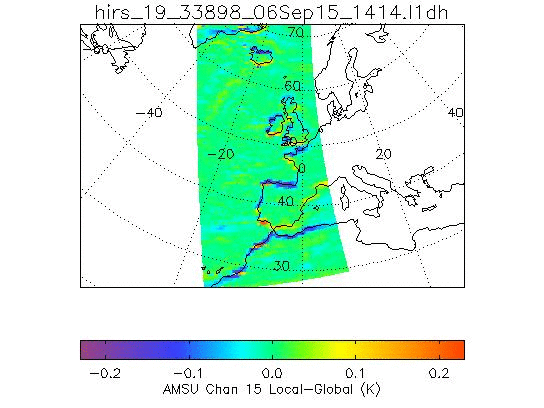Introduction
Monitoring

Example from the DBnet monitoring pages – a map of the brightness temperature difference between RARS and global data for AMSU-A channel 15 of the NOAA-15 satellite.
Monitoring of satellite data used in operational NWP is a critical activity. The NWP SAF monitoring covers the following data type categories:
- Level-1 products (radiances)
- Level-2 derived products (atmospheric motion vectors, scatterometer surface winds and ozone products).
and is divided into 2 complementary activities:
- Near-real time (NRT) monitoring and anomaly alert focuses primarily on quality checks of the available systems. This helps to ensure that forecast quality is not compromised by degraded performance of the data, which can occur due to instrument degradation or errors within the product delivery chain. There are several elements to this:
NRT availability Information on NRT data coverage and reception timeliness NRT quality statistics Focus on instantaneous quality (noise, bias, stability) and time evolution of the NRT data Data alerts Automatic interrogation of the global monitoring to identify potential anomalies and communicate as alerts to data providers and wider user community DBNet monitoring Checks availability and consistency of data from the direct broadcast network compared with global datasets - Data assessment, impact and investigation focuses on more in-depth assessment of data quality. This is very important as successful data usage requires a good understanding of data quality and long-term error characteristics including biases. This work should help to accelerate the identification of problems and exploitation of new datasets. The work here is divided into 2 categories:
Winds quality evaluation Monthly monitoring of AMVs and scatterometer winds to drive in-depth analysis of the data Radiance data quality assessments Reports on assessments of data quality from selected new satellite missions Data assimilation and Ensemble (DAE) diagnostics Provision of diagnostics, forecast sensitivity to observations (FSO) and others, providing additional information on the value of observing systems.
You can see what types of monitoring is planned for recently launched and upcoming satellite instruments on the planned monitoring page.
Further information and links to the monitoring charts can be accessed using the Monitoring drop-down tabs above.
Satellite monitoring time-series using ERA-5 as the reference atmospheric state
To support users involved in climate applications, long time-series quality statistics for satellites monitored against the ERA-5 reference are also available. Further information can be found in Release of new NWP SAF ERA-5 satellite monitoring
The monitoring can be accessed on the ECMWF monitoring site.
